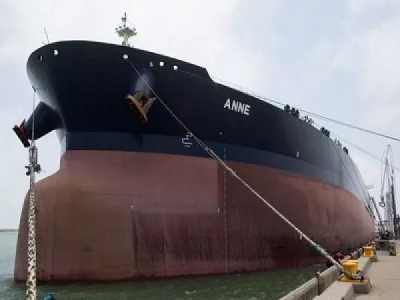
Posted on May 17, 2018
By Tim Acosta, Caller Times
If the Port of Corpus Christi fulfills its grand plans for Harbor Island, the property could become a jewel of the shipping industry.
Whether that dream is feasible is still to be determined.
Port commissioners on Tuesday voted to approve a number of measures to determine the feasibility of a proposed crude oil storage terminal on Harbor Island. The port is looking at the possibility of dredging a portion of the Corpus Christi Ship Channel — from the channel entrance all the way to the La Quinta Junction near in Ingleside — down to 75 feet.
That would allow for the proposed Harbor Island terminal to handle Very Large Crude Carrier vessels, which can carry 2 million barrels of crude fully loaded.
“There’s been a lot of discussion about VLCC-capable facilities on the U.S. Gulf Coast,” said Port of Corpus Christi CEO Sean Strawbridge. “Other ports have expressed interest in looking at that — certainly our customers have expressed interest — and that’s why we’re presenting this to you, is because the market is asking us to explore the feasibility in being able to go deeper.”
The port commission later approved the selection of Los Angeles-based engineering firm AECOM for a $5.2 million contract to conduct feasibility and environmental studies related to the proposed 75-foot dredging project. The proposal is being explored primarily because of the surging demand for crude oil overseas.
The Port of Corpus Christi is now the nation’s leading exporter of crude oil, and there are several pipeline projects that are in the works or have been proposed that would transport crude oil from the Permian Basin and Eagle Ford Shale to the port for distribution globally. This could also help reduce the nation’s trade deficit, port officials have said.
But that growth could be hampered if the port is unable to meet the capacity coming its way. The port is in the midst of expanding its ship channel in a $327 million project, which would widen the channel and deepen it to 54 feet. That would allow for the full loading of Suezmax oil tankers capable of carrying 1 million barrels of crude.
Currently, to be fully loaded, those types of vessels have to be partially filled in the port and then transported out into the Gulf of Mexico. The remaining crude is then ferried out to the vessel, which can mean an additional cost for companies. The deepening would reduce those costs, making the port more competitive and likely resulting in additional growth.
That means timing is key.
The current ship channel expansion project is scheduled for completion in 2021, around the same time the taller replacement to the Harbor Bridge will be ready for use. Port officials are hoping to have the feasibility and environmental studies for the 75-foot project done by April 2019, with the goal of having it done the same year as the original 54-foot deepening project.
That’s going to be a test for the engineering firm, as typical feasibility and environmental studies for these types of projects take up to three years to complete.
“We’re striving to complete this work in an expeditious manner,” said Dan Koesema, chief of channel development for the Port of Corpus Christi.
Ashley Judith, with AECOM, said the company was confident it could meet the aggressive timeline by limiting redundant processes. Some of the paperwork required by the Army Corps of Engineers for different parts of the process may not need to be redone, and can be used in multiple instances, she said.
“The process requires multiple approvals, which requires multiple documents,” she said. “Therefore, our strategy will be to minimize separate documents and have concurrent reviews.”
Port commissioners also approved a $283,000 contract with Wood Environment & Infrastructure Solutions, Inc., for engineering and planning services related to the possible development of the crude oil export terminal for VLCCs on Harbor Island.
As the name states, the feasibility study for the Harbor Island project will determine whether the project is even viable. The project scope could be reduced, or it could turn out to be too expensive to proceed at this time. The port won’t know until the study is done and there’s data to review, officials said, and port leaders are also seeking input from vessel pilots.
“Look at everything — the good, the bad, the ugly,” Port Commissioner Barbara Canales said.
“We will not know the feasibility until we actually know what this study tells us,” Strawbridge later replied.
Harbor Island has seen industrial use in the past, and was formerly a terminal site for Exxon decades ago. But those assets were later removed and the site cleaned up. The port came into possession of the 250 acres of land in 1996, as part of a land swap with Flint Hills Resources.
Martin Midstream proposed a condensate splitter facility on Harbor Island several years ago, but residents in Port Aransas voiced opposition to the project and a lawsuit was later filed challenging the bidding process for the sale of the land. The project and purchase were later cancelled.
The port’s Harbor Island project would not involve any refining, but would act as a storage terminal for crude oil to be loaded onto VLCCs. That oil would be supplied to the storage tanks via pipeline, officials have said.
Source: Caller Times





